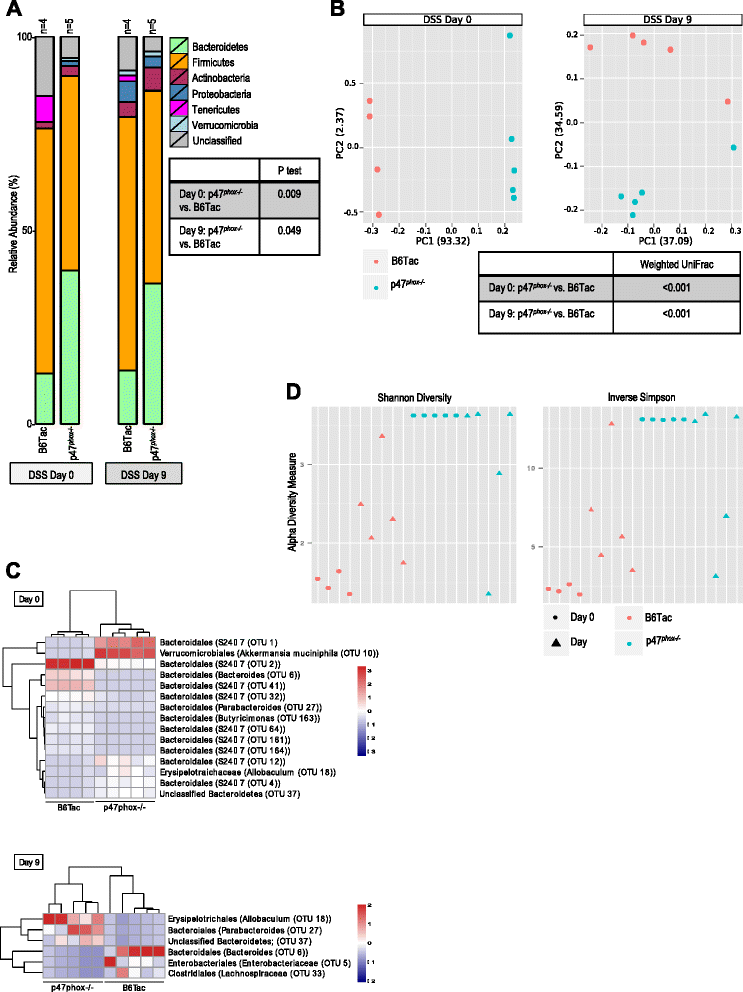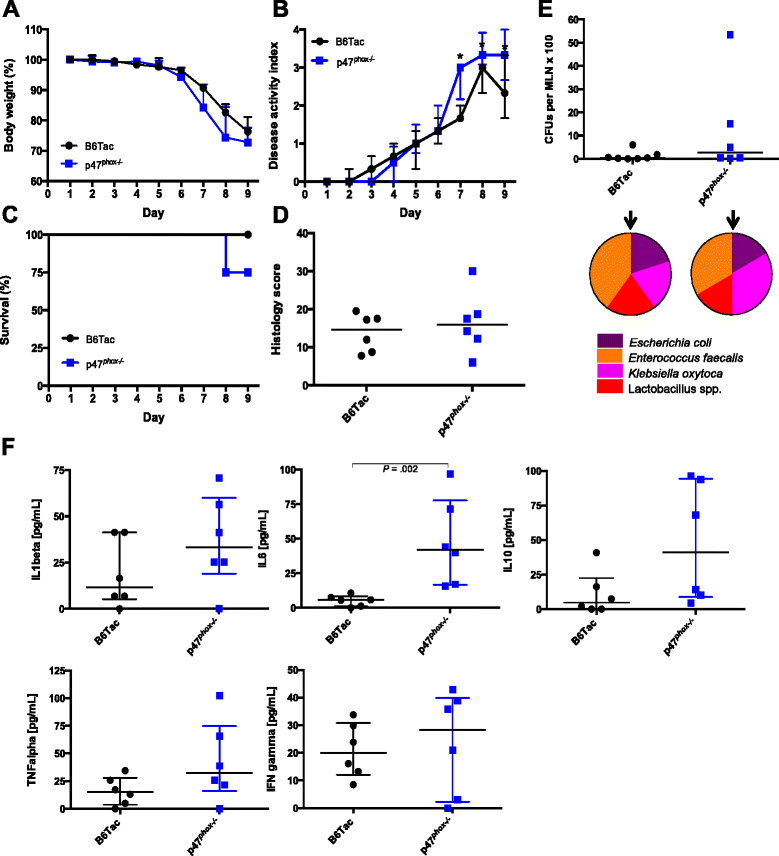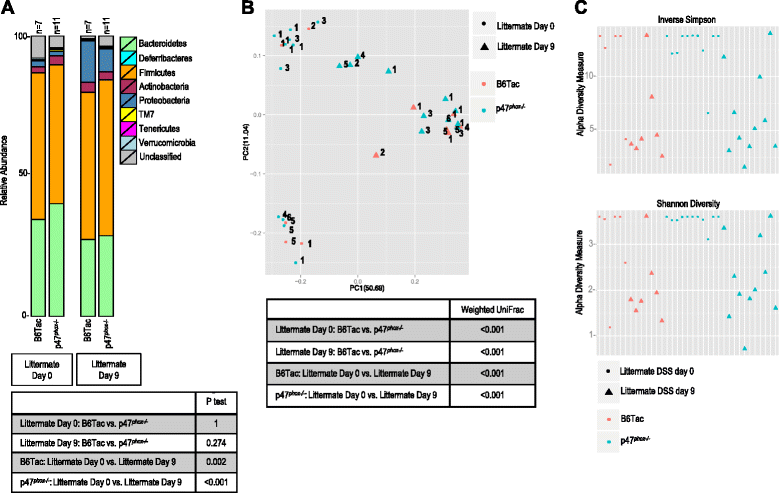Colitis susceptibility in p47(phox-/-) mice is mediated by the microbiome
- PMID: 27044504
- PMCID: PMC4820915
- DOI: 10.1186/s40168-016-0159-0
Colitis susceptibility in p47(phox-/-) mice is mediated by the microbiome
Abstract
Background: Chronic granulomatous disease (CGD) is caused by defects in nicotinamide adenine dinucleotide phosphate oxidase 2 (NOX2) complex subunits (gp91(phox) (a.k.a. Nox2), p47(phox), p67(phox), p22(phox), p40(phox)) leading to reduced phagocyte-derived reactive oxygen species production. Almost half of patients with CGD develop inflammatory bowel disease, and the involvement of the intestinal microbiome in relation to this predisposing immunodeficiency has not been explored.
Results: Although CGD mice do not spontaneously develop colitis, we demonstrate that p47(phox-/-) mice have increased susceptibility to dextran sodium sulfate colitis in association with a distinct colonic transcript and microbiome signature. Neither restoring NOX2 reactive oxygen species production nor normalizing the microbiome using cohoused adult p47(phox-/-) with B6Tac (wild type) mice reversed this phenotype. However, breeding p47(phox+/-) mice and standardizing the microflora between littermate p47(phox-/-) and B6Tac mice from birth significantly reduced dextran sodium sulfate colitis susceptibility in p47(phox-/-) mice. We found similarly decreased colitis susceptibility in littermate p47(phox-/-) and B6Tac mice treated with Citrobacter rodentium.
Conclusions: Our findings suggest that the microbiome signature established at birth may play a bigger role than phagocyte-derived reactive oxygen species in mediating colitis susceptibility in CGD mice. These data further support bacteria-related disease in CGD colitis.
Keywords: Chronic granulomatous disease; Colitis; Dextran sodium sulfate; Inflammatory bowel disease; Microbiome; NADPH; Reactive oxygen species; p47 phox.
Figures








Similar articles
-
Reactive oxygen species regulate early development of the intestinal macrophage-microbiome interface.Blood. 2025 May 1;145(18):2025-2040. doi: 10.1182/blood.2024025240. Blood. 2025. PMID: 39899882
-
Genotype-specific immune responses at the intestinal barrier predispose to colitis in mouse models of chronic granulomatous disease.Blood. 2025 Jun 26;145(26):3153-3165. doi: 10.1182/blood.2024026332. Blood. 2025. PMID: 40239128
-
Variants in nicotinamide adenine dinucleotide phosphate oxidase complex components determine susceptibility to very early onset inflammatory bowel disease.Gastroenterology. 2014 Sep;147(3):680-689.e2. doi: 10.1053/j.gastro.2014.06.005. Epub 2014 Jun 12. Gastroenterology. 2014. PMID: 24931457
-
Chronic Granulomatous Disease: a Comprehensive Review.Clin Rev Allergy Immunol. 2021 Oct;61(2):101-113. doi: 10.1007/s12016-020-08800-x. Clin Rev Allergy Immunol. 2021. PMID: 32524254 Review.
-
[Gene therapy for inherited diseases using heamatopoietic stem cells--gene therapy for patients with chronic granulomatous disease].Hum Cell. 1999 Sep;12(3):103-8. Hum Cell. 1999. PMID: 10695016 Review. Japanese.
Cited by
-
The Dual Role of Neutrophils in Inflammatory Bowel Diseases.J Clin Med. 2016 Dec 17;5(12):118. doi: 10.3390/jcm5120118. J Clin Med. 2016. PMID: 27999328 Free PMC article. Review.
-
Significance of Microbiota in Obesity and Metabolic Diseases and the Modulatory Potential by Medicinal Plant and Food Ingredients.Front Pharmacol. 2017 Jun 30;8:387. doi: 10.3389/fphar.2017.00387. eCollection 2017. Front Pharmacol. 2017. PMID: 28713266 Free PMC article. Review.
-
From Flies to Men: ROS and the NADPH Oxidase in Phagocytes.Front Cell Dev Biol. 2021 Mar 26;9:628991. doi: 10.3389/fcell.2021.628991. eCollection 2021. Front Cell Dev Biol. 2021. PMID: 33842458 Free PMC article. Review.
-
NOTCH-induced rerouting of endosomal trafficking disables regulatory T cells in vasculitis.J Clin Invest. 2021 Jan 4;131(1):e136042. doi: 10.1172/JCI136042. J Clin Invest. 2021. PMID: 32960812 Free PMC article.
-
The Effects of Phytase and Non-Starch Polysaccharide-Hydrolyzing Enzymes on Trace Element Deposition, Intestinal Morphology, and Cecal Microbiota of Growing-Finishing Pigs.Animals (Basel). 2023 Feb 4;13(4):549. doi: 10.3390/ani13040549. Animals (Basel). 2023. PMID: 36830337 Free PMC article.
References
Publication types
MeSH terms
Substances
Grants and funding
LinkOut - more resources
Full Text Sources
Other Literature Sources
Molecular Biology Databases
Miscellaneous

